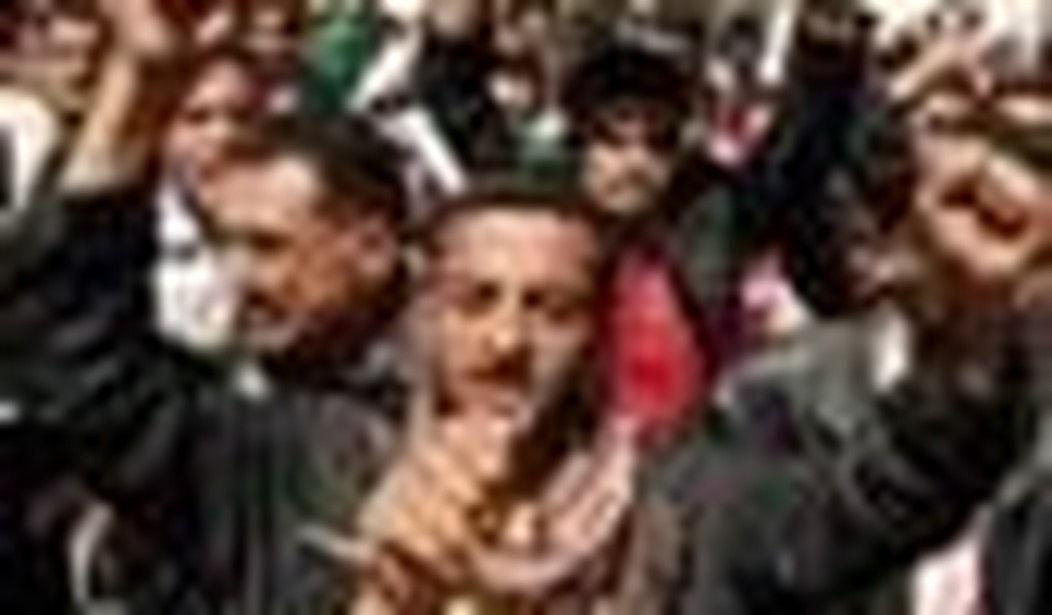“We must stand alongside those who believe in the same core principles,” President Obama said in his speech Monday night justifying American military intervention in Libya. But there is reason to doubt that the eastern Libyan forces opposed to the rule of Moammar al-Gaddafi do share our core principles — at any rate, if by “our” principles the president means American ones.
This is not only because, as reported on PJM, the rebel forces contain al-Qaeda linked elements that have fought against America in both Afghanistan and Iraq. A look back at the origins of the eastern Libyan rebellion suggests that it has been an essentially Islamist rebellion from the start. Indeed, little known to most Americans, one of the principal sources of inspiration for the rebellion is to be found in that most Islamist of all sources of outrage: the famous “Mohammed cartoons” published by the Danish newspaper Jyllands-Posten in 2005.
The eastern Libyan rebellion began with a “Day of Rage” on February 17. The “Day of Rage” was called by an organization named the National Conference for the Libyan Opposition (NCLO). The choice of the date was not arbitrary. According to the English edition of the pan-Arab newspaper Asharq Al-Awsat, the date was chosen to commemorate “the 17 February 2006 uprisings in the city of Benghazi where protests against the Danish cartoons of the prophet Muhammad were transformed into mass demonstrations against Gaddafi and his regime, resulting in the death of dozens of protestors and the injury of many more.”
Reports at the time, citing official Libyan sources, spoke of eleven confirmed dead. The deaths occurred when rioters attempted to storm the Italian consulate in Benghazi. The building was set on fire and consulate personnel had to be evacuated. “We feared for our lives,” the wife of the consul general was quoted as saying in the Italian daily Corriere della Sera. A consulate employee spoke of “thousands” of young men that descended upon the consulate, coming from the local mosques. February 17, 2006, was a Friday, so the rioters were presumably coming from Friday prayers. After initially attempting to disperse the crowd with tear gas, Libyan police opened fire.
The 2006 attack on the Italian consulate helps to explain the reluctance of Italian authorities to support the eastern Libyan rebels and their ambivalence about the Western-led military intervention.
The rage of the Benghazi rioters appears to have been specifically directed at the Italian consulate as a consequence of a television appearance two days earlier by Italian “Reforms Minister” Roberto Calderoli. In reaction to the protests against the Mohammed cartoons in Muslim countries, Calderoli had previously announced that he intended to print up t-shirts with a cartoon of Mohammed on them and to wear one himself. During an interview on the Italian public television Rai Uno on February 15, Calderoli did not merely defend the idea; he proceeded to unbutton his shirt and show that he was in fact wearing such a t-shirt.
Calderoli explained that the gesture was a matter of a “battle for freedom.” Alluding to the cartoon protestors, he added defiantly, “When they recognize our rights, I’ll take off the shirt.” According to the Corriere della Sera, Calderoli’s counter-protest was widely reported in Arab media.
The day after the Benghazi riots, Calderoli resigned from his post in the Italian government. In a statement, he said that “it has never been my intention to offend the Muslim religion nor to be a pretext for yesterday’s violence.” But he also described the violence sparked by the cartoons in Muslim countries more generally as “a veritable attack on the West, which worries me and should worry everyone whose responsibility it is to see to it that diverse cultures live together peacefully.”
The role played by the Mohammed cartoons in the history of the Libyan rebellion is by no means the only indication of the latter’s Islamist inspiration. The president of the United States and other Western leaders and opinion-makers have lately been busy parsing the statements of the so-called Transitional National Council, which has served as the political face of the rebellion vis-à-vis the international community. Someone going by the name of Andy Stone, on the other hand, had the idea of examining the Arabic contents found on the website of the National Conference for the Libyan Opposition.
Stone, who published his findings online here, discovered an NCLO document titled “Gaddafi: Islam’s no. 1 Enemy.” The document was published on February 15 of this year, just two days before the NCLO-sponsored “Day of Rage” protests in Benghazi.
The document amounts to an indictment of Muammar al-Gaddafi on account of a long list of alleged crimes against Islamic orthodoxy. These include, for instance, Gaddafi’s insistence that Christians and Jews should be allowed to visit Mecca.
For the charges leveled against Muammar al-Gaddafi in the NCLO’s “Gaddafi: Islam’s Enemy no. 1,” see Tony Badran’s English translation on the Tatler.









Join the conversation as a VIP Member